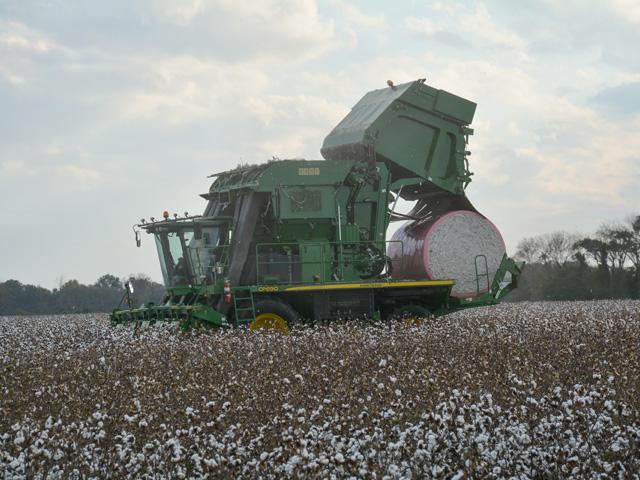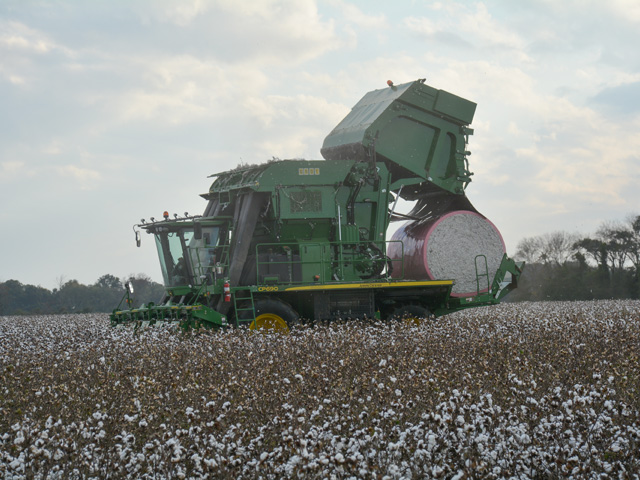Production Blog
Midwesterner Gets Crash Course in Cotton Harvesting
ANKENY, Iowa (DTN) -- I'm an Iowa farm kid turned ag journalist that spent most of my career writing about corn, soybeans and livestock. Before I joined the news staff of DTN/Progressive Farmer more than 2 1/2 years ago, I had never written a cotton story.
I've written a handful of cotton articles since then about production, marketing and disease issues. But to be honest, it was a challenge because I had never been in a cotton field to learn first-hand from farmers and suppliers what it takes to earn a living raising fiber. That changed in mid-October when I spent four days in Arkansas, Mississippi and Tennessee during cotton harvest. The learning experience was invaluable.
The differences between what it takes to grow, harvest and market cotton compared to Midwest row crops are vast -- tillage, equipment, terminology, insect and weed pressure and ginning are just a few. But the similarities among farmers, regardless of what they grow, are many. These include a love of the land and family, and dealing with weather, pest and market uncertainties.
I learned a lot about cotton production, processing and marketing during my time in the Delta region, but I know I only scratched the surface. Educating oneself, of course, is a lifelong pursuit.
Here are some observations and lessons I learned about cotton -- along with links to a story and videos -- from an admitted novice, that may be interesting to Midwesterners like me who know little about this fascinating crop.
-- The number of field passes it takes to grow cotton in the Delta region can dwarf the passes needed in the Midwest for corn and soybean production. Farmers reported spraying for insects, such as plant bugs, as often as once a week this year for a couple of months. Cotton in the Delta is grown on raised beds, which are made by specialized tillage equipment, for furrow irrigation and to keep plants out of standing water. Four or more herbicide applications may be needed to keep weeds such as Palmer amaranth at bay, along with chopping crews to physically remove the yield-robbing weed.
P[L1] D[0x0] M[300x250] OOP[F] ADUNIT[] T[]
-- Most mature, bushy cotton plants are 3 to 5 feet tall with tough stems that resemble small tree trunks. After bolls open, exposing white, fluffy lint, it's a stunning sight to see in person.
-- The largest cotton pickers only harvest six rows at a time, which isn't very many compared to today's corn heads. Calmer Corn Heads has the largest at 32 rows. However, corn rows are typically narrower than cotton. In the Delta, 38-inch cotton rows are common. After seeing the amount of tough plant material a cotton picker takes in, I can see why a head is limited to six rows.
-- The number of moving parts on a cotton picker is mindboggling. I thought combines were complex. The picker cab is pretty similar to a combine, but it's a little quieter for the operator. When the picker is harvesting cotton, it sounds like a quiet jet engine with all the air moving through the machine.
-- I was puzzled by the amount of cotton left after a picker makes a pass. A harvester is set up to remove as much cotton as possible, but it can't get it all due to the sheer volume to process. I asked several farmers why they don't send the machine through again to get it all. The answer was the same: It would take several hours for one picker to make one round bale, also called a "module." It's not economical or a good use of time to pick a field more than once since harvesters do such a good job the first time. Here's a video of the cotton harvest: https://www.dtnpf.com/….
-- A wrapped round bale or module of cotton from the field usually weighs nearly 3 tons. It contains lint, cotton seed and plant/field debris.
-- Round cotton bales are transported to a cotton gin to separate the lint, seed and trash. Most gins in the Delta region are paid by keeping the cotton seed to sell for livestock feed and oil, though some do charge by the bale. Tri Watkins, co-owner of Rabbit Ridge Gin Company near Dyess, Arkansas, said it takes about 1,500 pounds of unginned cotton to make a 480-pound bale of ginned cotton since roughly 600 pounds will be seed and 400 pounds will be trash.
-- The ginning process, which is basically the same since Eli Whitney made the first cotton gin, is fascinating. Cotton modules are ripped apart, cotton is dried and then run through a series of machines to separate the lint, seed and foreign matter. At the end of the process, a 480-pound bale of cotton is produced that will be shipped to spinners, textile mills and other end users. Watch a video of the ginning process here: https://www.dtnpf.com/….
-- Each bale of cotton from the field receives its own identification number, which will match ginned bales. Traceability is important to the cotton industry.
-- The cotton grading process is complex. USDA grades all ginned cotton. Universal Cotton Standards consist of color and leaf grade standards, calibration cottons for length, strength, uniformity index and micronaire, and verification standards for instrument color and trash content. Find out more at www.ams.usda.gov/grades-standards/cotton.
-- Cotton quality can affect prices paid to farmers. The higher the quality, the better the premium. Watkins said premiums of 2 to 4 cents per pound were common as harvest neared the halfway point.
-- One 480-pound bale of ginned cotton can make 215 pairs of jeans or 249 bed sheets or 690 Terry bath towels. More examples can be found at www.cotton.org/pubs/cottoncounts/what-can-you-make.cfm.
-- The 2021 cotton harvest will be a memorable one with promising yields for many growers and projected record-high prices. Read more about that at www.dtnpf.com/agriculture/web/ag/crops/article/2021/10/28/farmers-harvest-2021-cotton-fetch.
Matthew Wilde can be reached at matt.wilde@dtn.com
Follow him on Twitter @progressivwilde
(c) Copyright 2021 DTN, LLC. All rights reserved.






Comments
To comment, please Log In or Join our Community .